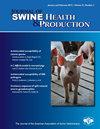商品化猪流行性腹泻病毒疫苗降低母猪病毒脱落时间的效果
IF 0.7
4区 农林科学
Q3 Agricultural and Biological Sciences
引用次数: 3
摘要
目的:评估使用市售的猪流行性腹泻病毒(PEDV)灭活疫苗是否能缩短替代母猪的PEDV脱落时间。材料和方法:本研究采用四个治疗组,每组20名女性。对照组的Gilts之前没有接触过PEDV,未接种疫苗(NV)组之前曾接触过,PRE组和POST组分别在接受PEDV攻击之前或之后接受了两剂商业杀死的PEDV疫苗。每周采集单个粪便样本,并通过实时逆转录聚合酶链式反应(rRT PCR)进行病毒检测。结果:与幼稚动物的粪便样本相比,先前接触PEDV可以缩短在粪便中检测到病毒的时间(P<.001)。无论是在攻击之前还是之后接种疫苗,都没有发现可以缩短PEDV在粪便中脱落的时间。含义:这些结果表明,在攻击之前或之后,用杀死的商业PEDV疫苗接种母猪并没有缩短通过rRT PCR在粪便中检测到病毒的时间,这表明粪便中的病毒脱落不受杀死的商业疫苗的影响。虽然先前感染毒性PEDV并不能防止再次感染,但它确实对随后暴露后检测到病毒的时间有显著影响。本文章由计算机程序翻译,如有差异,请以英文原文为准。
Efficacy of a commercial porcine epidemic diarrhea virus vaccine at reducing duration of viral shedding in gilts
Objective: To evaluate if the use of a commercially available killed porcine epidemic diarrhea virus (PEDV) vaccine shortens the duration of PEDV shedding in replacement gilts. Materials and methods: Four treatment groups composed of 20 females were utilized for this study. Gilts in the CONTROL group had no previous exposure to PEDV, the nonvaccinated (NV) group had been previously exposed, and the PRE and POST groups received two doses of a commercial, killed PEDV vaccine either prior to or following a challenge with PEDV, respectively. Individual fecal samples were collected weekly and tested by real-time reverse transcription-polymerase chain reaction (rRT-PCR) for virus detection. Results: Previous exposure to PEDV was found to shorten the time that virus can be detected in the feces compared to fecal samples of naïve animals (P < .001). Vaccination, either prior to or following the challenge, was not found to shorten the duration of PEDV shedding in feces. Implications: These results showed that vaccination of gilts, either prior to the challenge or afterwards, with a killed commerical PEDV vaccine did not shorten the period that virus was detectable in the feces by rRT-PCR suggesting that viral shedding in feces was not influenced by administration of a killed commercial vaccine. While previous infection with virulent PEDV did not prevent re-infection, it did have a significant effect on the amount of time virus was detected following a subsequent exposure.
求助全文
通过发布文献求助,成功后即可免费获取论文全文。
去求助
来源期刊
CiteScore
1.80
自引率
0.00%
发文量
29
审稿时长
>36 weeks
期刊介绍:
The Journal of Swine Health & Production (JSHAP) is an open-access and peer-reviewed journal published by the American Association of Swine Veterinarians (AASV) since 1993. The aim of the journal is the timely publication of peer-reviewed papers with a scope that encompasses the many domains of applied swine health and production, including the diagnosis, treatment, management, prevention and eradication of swine diseases, welfare & behavior, nutrition, public health, epidemiology, food safety, biosecurity, pharmaceuticals, antimicrobial use and resistance, reproduction, growth, systems flow, economics, and facility design. The journal provides a platform for researchers, veterinary practitioners, academics, and students to share their work with an international audience. The journal publishes information that contains an applied and practical focus and presents scientific information that is accessible to the busy veterinary practitioner as well as to the research and academic community. Hence, manuscripts with an applied focus are considered for publication, and the journal publishes original research, brief communications, case reports/series, literature reviews, commentaries, diagnostic notes, production tools, and practice tips. All manuscripts submitted to the Journal of Swine Health & Production are peer-reviewed.

 求助内容:
求助内容: 应助结果提醒方式:
应助结果提醒方式:


